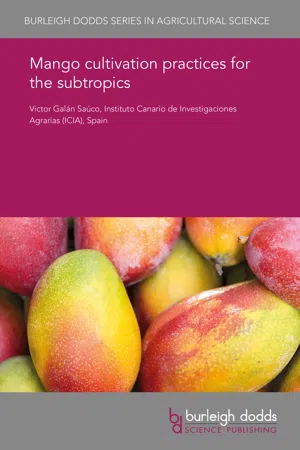
eBook - PDF
Mango cultivation practices for the subtropics
Victor Galán Saúco
This is a test
- English
- PDF
- Available on iOS & Android
eBook - PDF
Mango cultivation practices for the subtropics
Victor Galán Saúco
Book details
Table of contents
Citations
About This Book
Mango is well adapted to hot, tropical climates. However, it can also be grown in the mild subtropics, where cooler winter temperatures improve flower induction and cause early bearing and lower annual growth rates, which help to control size and favour high-density plantings. There are also disadvantages to growing mango in the subtropics: cold spells and low temperatures can damage vulnerable young trees or areas of young growth, or can induce flowering of very young trees at the nursery, causing premature ageing of inadequately managed plants. This chapter reviews the differences between mango cultivation in tropical and subtropical climates and explores the factors necessary for successful subtropical cultivation.
Frequently asked questions
How do I cancel my subscription?
Can/how do I download books?
At the moment all of our mobile-responsive ePub books are available to download via the app. Most of our PDFs are also available to download and we're working on making the final remaining ones downloadable now. Learn more here.
What is the difference between the pricing plans?
Both plans give you full access to the library and all of Perlego’s features. The only differences are the price and subscription period: With the annual plan you’ll save around 30% compared to 12 months on the monthly plan.
What is Perlego?
We are an online textbook subscription service, where you can get access to an entire online library for less than the price of a single book per month. With over 1 million books across 1000+ topics, we’ve got you covered! Learn more here.
Do you support text-to-speech?
Look out for the read-aloud symbol on your next book to see if you can listen to it. The read-aloud tool reads text aloud for you, highlighting the text as it is being read. You can pause it, speed it up and slow it down. Learn more here.
Is Mango cultivation practices for the subtropics an online PDF/ePUB?
Yes, you can access Mango cultivation practices for the subtropics by Victor Galán Saúco in PDF and/or ePUB format, as well as other popular books in Tecnología e ingeniería & Agricultura. We have over one million books available in our catalogue for you to explore.
Information
Subtopic
AgriculturaTable of contents
- 1 Introduction
- 2 Tropical versus subtropical mango cultivation: climatic considerations
- 3 Exploiting genetic variation among mango cultivars
- 4 Cultural techniques: planting density, spacing and out-of-season production
- 5 Cultural techniques: control of growth and flowering
- 6 Conclusion
- 7 Where to look for further information
- 8 References
Citation styles for Mango cultivation practices for the subtropics
APA 6 Citation
Saúco, V. G. (2018). Mango cultivation practices for the subtropics ([edition unavailable]). Burleigh Dodds Science Publishing. Retrieved from https://www.perlego.com/book/1435555/mango-cultivation-practices-for-the-subtropics-pdf (Original work published 2018)
Chicago Citation
Saúco, Victor Galán. (2018) 2018. Mango Cultivation Practices for the Subtropics. [Edition unavailable]. Burleigh Dodds Science Publishing. https://www.perlego.com/book/1435555/mango-cultivation-practices-for-the-subtropics-pdf.
Harvard Citation
Saúco, V. G. (2018) Mango cultivation practices for the subtropics. [edition unavailable]. Burleigh Dodds Science Publishing. Available at: https://www.perlego.com/book/1435555/mango-cultivation-practices-for-the-subtropics-pdf (Accessed: 14 October 2022).
MLA 7 Citation
Saúco, Victor Galán. Mango Cultivation Practices for the Subtropics. [edition unavailable]. Burleigh Dodds Science Publishing, 2018. Web. 14 Oct. 2022.